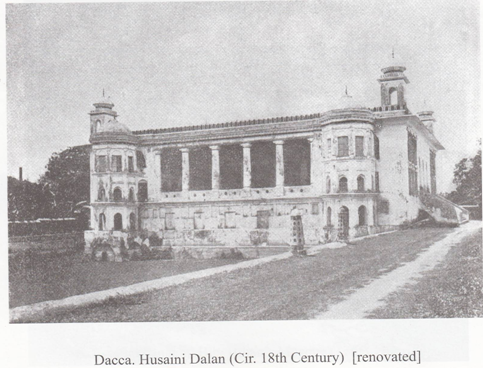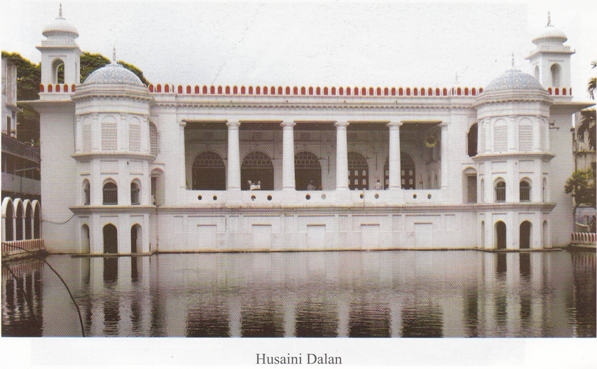Hussaini Dalan Dhaka
We now come back to the jail and follow Sir Nazimuddin Road and come towards Ramna side. On way, before the Rail crossing, [the railway line has been removed from this area. and is has been converted into a road, and hence the Railway crossing non-existent at present] a pathway called Hussaini Dalan Road goes towards the west. [This road is just before the meeting point of the Nazimuddin Road and the new road on the Railway line.] It lead to Hussaini Dalan (pl. 20.1&20.2), the famous Imambara (religious monument) of the Shiah community of the Muslims. We enter into the walled compound through a grand portal. In the centre stands the Dalan on the northern bank of a tank. The Muharram is celebrated here annually with great eclat (for Muharram celebration see above).
A lot of controversy has been raised over the date of its erection. Hakim Habibur Rahman repudiates the date 1052 A.H. (A.D. 1642) supplied by a reddish sandstone inscription fixed on the east wall of the main building and rightly believes that the inscription is spurious. He does not regard Mir Murad as the builder of this Imambara. According to him a small tazia—khana was in existence from an unknown date, and Nawab Nasrat Jasrat Jang (died in A.D. 1823) erected the present magnificent building, to which later repairs were executed by Nawab Sir Ahsanullah after the earthquake of 1897. Charles D’Oyly, when he made his sketches in 1808, drew the picture of the Chauk Mosque and wrote, “The stately mosque which appears beyond the market, is the principal place of worship of the present Nawaub, who is a devout Mussulman. It was built in the year 1676, and is called the HOSSEINEE DALAN.” Here D’Oyly has decidedly mistaken the Chauk mosque for Hussaini Dalan, the picture of the latter he has not given at all. In 1832 Dr. Taylor wrote, “The principal Mahommedan places of worship are the Edgah and Hossainee Delaun….the latter is said to have been built by a person named Mir Murad, who held the Darogahship of the Nawarrah Mehals, and had charge of the public buildings in the time of Sultan Muhammad Azam. The tradition regarding the latter edifice is, that Mir Murad saw in a vision, Emam Hossain erecting a Taziah Khanah or house of mourning, and that he was induced in consequence to raise the present building, which he named Hossainee Delaun. He defrayed the expense of illuminating it during the mohurrum, and of feeding the poor at this festival, and the allowance then established by him was continued by the Governors of this province. The annual sum of Rs. 2,500/- is at present given by the Government to the Nawaub for the same purpose.” D’Oyly was a contemporary of Nasrat Jang and Taylor came a little later. None of them speaks of Nasrat Jang having built the Hussaini Dalan. Therefore, the contention of Hakim Habibur Rahman cannot be accepted. Some construction must have been made by Mir Murad, though his date is not certain. Taylor placed him in the time of Muhammad Azam, i.e., 1678-79, while the date of his death, according to an inscription found here is 1131 A.H. (A.D. 1718). What was the form of the original building cannot be ascertained now, because no one has described it. The local tradition says that Nawab Jasarat Khan rebuilt the Hussaini Dalan in the second half of 18th century, and its features, noted by Hakim Habibur Rahman, support it.
Hussaini Dalan Dhaka


